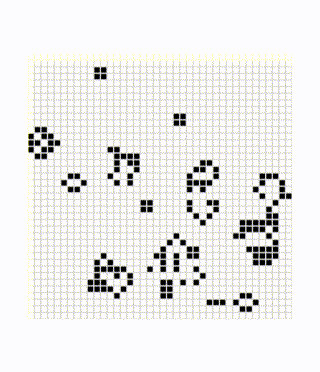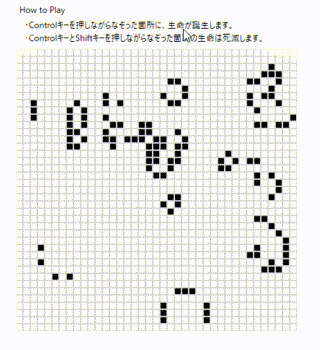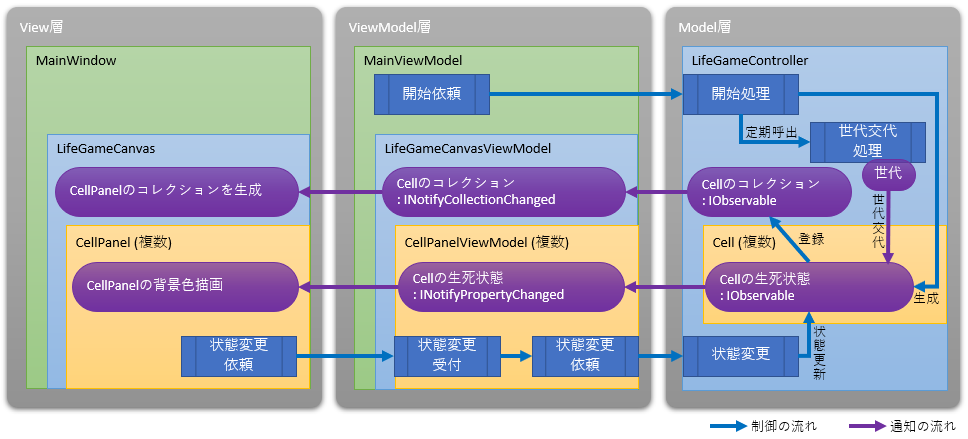17年プログラマをやっていますが、どうにもObserverパターンがしっくりこないのでLifeGameで自主練してみました。
ことはじめ
業務でReactiveUIを利用しているのですが、どうにもしっくり来ていませんでした。
しかしobserverパターンは苦手だ。アタマに馴染まないというか、、、。昨晩もModel層のコレクションの変化をViewModel層に通知するインターフェースの最適解について、納得いく答えに辿り着けたのは、朝3:30。。。
— kami_teru (@kami_teru) January 23, 2021
だけど頑張りました。
今週はobserverパターンと良い友達になれた気がした。
— kami_teru (@kami_teru) January 29, 2021
そんな折、ふとアイデアが降臨。
昔に参加したグローバルディズ オブ コードリトリート で、ペアプロで一度も作りきれなかったライフゲーム、今なら作れるか試してみたくなった。
— kami_teru (@kami_teru) January 30, 2021
当時、何度やっても45分で完成させることができなかったのですよねー。
探してみたらありました。
懐かしいなぁ。すげぇ人たちと沢山出逢って......そうそう、心くじけて「C#できます」っていうのを止めようと思ったのがこの会で。あとピザ旨かった。
あれから9年。Observerパターンと友達になった今の私なら、1時間くらいでサクッと作れんじゃね?と思い立ち。
やってみた話をここにまとめます。
できたもの
お忙しい方に私のチャレンジストーリーをお読みいただくのは心苦しいので、先に学習の結果を出しておきます。
フレームワーク/バージョン
- .Net Framerork 4.7.2 & WPF
- ReactiveUI.WPF 12.1.1
- ReactiveUI.Fody 12.1.1
構造
ReactiveUI的なところを補足しておくと、こういうクラスを利用します。
- Model層の世代の変更を通知する方法。
| 実装 | Subject<int> |
| 通知インターフェース | IObservable<int> |
- Model層のCellの生死状態の変更を通知する方法。
| 実装 | ReactiveUI.ReactiveObject |
| 通知インターフェース | IObservable<IReactivePropertyChangedEventArgs<IReactiveObject>> |
- Model層のCellのコレクションの変更を通知する方法。
| 実装 | DynamicData.SourceCache<Cell, Tuple<int, int>> |
| 通知インターフェース | IObservable<IChangeSet<Cell, Tuple<int, int>>> |
完成したソースコード
やってみた話
ここから、完成に至るまでの私のストーリー。
そんなのいらない?
い、いや、ソースコードの説明とか入れていくので、ぜひ読んでほしいですおねがいします🙇♂️💦
では、果たして「1時間くらいでサクッと」作れたのか?
以下、ぜひお読みください。
まずはざっくり構想した。
こんな構造で作ります。
Model層
- LifeGameController は、
開始依頼を受信すると、Cell のコレクションを生成します。 - LifeGameController は、タイマーによって定期的に
世代交代を通知します。 - Cell は、
世代交代を監視し、受信時に自身の生死状態を更新する処理を行います。 - Cell は、隣接 Cell の
生死状態を監視し、生死判定で使う近隣生死状態情報を作っておきます。
ViewModel層
- MainViewModel は、起動時に
行数,列数,タイマー間隔,初期生死状態情報を引数に、Controllerオブジェクトに開始依頼を送ります。 - LifeGameCanvasViewModel は、LifeGameController の Cell のコレクションを監視し、ViewModelに同期します。
- CellPanelViewModel は、Cell の
生死状態を監視し、ViewModelに同期します。
View層
- LifeGameCanvas は、ViewModel の Cell のコレクションの変更を監視し、変更時には必要数分の CellPanel を Canvas に描画します。
- CellPanelは、ViewModel の
生死状態と背景色をバインドし、生なら黒、死なら白の背景色を描画します。
なにはともあれ、MVVMの構造を組む。
動かす仕組みがないとデバッグしづらいヨネ、ということで構成部品の枠組みを先にコーディング。
その時のソースがこれ。
LifeGame20210131_v0.1 - Github
Model層の実装
-
DynamicData.SourceListが Observer で、Connect()により Observable を生成。 - Cell のコレクションを必要数分の Cell で構成。
public class LifeGameController : ILifeGameController
{
protected SourceList<Cell> Cells { get; }
public LifeGameController()
{
Cells = new SourceList<Cell>();
}
IObservable<IChangeSet<Cell>> ILifeGameController.Connect()
{
return Cells.Connect();
}
Task ILifeGameController.InitializeAsync(int columns, int rows)
{
return Task.Run(() =>
{
for (int y = 0; y < rows; y++)
{
for (int x = 0; x < columns; x++)
{
Cells.Add(new Cell()
{
PositionX = x,
PositionY = y,
});
}
}
});
}
}
- Cell の処理の実装は未だ無い。
public class Cell
{
[Reactive]
public int PositionX { get; internal set; }
[Reactive]
public int PositionY { get; internal set; }
}
ViewModel層の実装
- LifeGameCanvasViewModel は起動時にLifeGameControllerの開始処理を呼び出す。
public class LifeGameCanvasViewModel : IActivatableViewModel
{
ViewModelActivator IActivatableViewModel.Activator => new ViewModelActivator();
public LifeGameCanvasViewModel()
{
this.WhenActivated(d =>
{
HandleActivation(d);
Disposable
.Create(() => this.HandleDeactivation())
.DisposeWith(d);
});
}
private void HandleActivation(CompositeDisposable d)
{
await Locator.Current.GetService<ILifeGameController>().InitializeAsync(columns: 10, rows: 10);
}
private void HandleDeactivation()
{
}
}
- CellPanelViewModel の処理の実装は未だ無い。
public class CellPanelViewModel
{
[Reactive]
public bool IsAlive { get; set; }
}
View層の実装
- MainWindowは、LifeGameController の
開始依頼を呼び出す。 - MainWindowは、デザインに LifeGameCanvas を配置しただけ。
<Window x:Class="WpfApp.MainWindow"
xmlns="http://schemas.microsoft.com/winfx/2006/xaml/presentation"
xmlns:x="http://schemas.microsoft.com/winfx/2006/xaml"
xmlns:d="http://schemas.microsoft.com/expression/blend/2008"
xmlns:mc="http://schemas.openxmlformats.org/markup-compatibility/2006"
xmlns:vw="clr-namespace:WpfApp.Views"
xmlns:local="clr-namespace:WpfApp"
mc:Ignorable="d"
Title="LifeGame" Height="200" Width="400">
<Grid>
<Grid.ColumnDefinitions>
<ColumnDefinition Width="*"/>
<ColumnDefinition Width="Auto"/>
<ColumnDefinition Width="*"/>
</Grid.ColumnDefinitions>
<Grid.RowDefinitions>
<RowDefinition Height="*"/>
<RowDefinition Height="Auto"/>
<RowDefinition Height="*"/>
</Grid.RowDefinitions>
<vw:LifeGameCanvas Grid.Column="1" Grid.Row="1" Width="100" Height="100"/>
</Grid>
</Window>
- LifeGameCanvasは、Grid にとりあえず10×10の Cell を固定配置してみた。
public partial class LifeGameCanvas : ReactiveUserControl<LifeGameCanvasViewModel>
{
public LifeGameCanvas()
{
InitializeComponent();
for (int x = 0; x < 10; x++)
{
Grid.ColumnDefinitions.Add(new ColumnDefinition()
{
Width = new GridLength(10.0, GridUnitType.Pixel),
});
}
for (int y = 0; y < 10; y++)
{
Grid.RowDefinitions.Add(new RowDefinition()
{
Height = new GridLength(10.0, GridUnitType.Pixel),
});
}
for (int y = 0; y < Grid.RowDefinitions.Count; y++)
{
for (int x = 0; x < Grid.ColumnDefinitions.Count; x++)
{
var cell = new CellPanel();
cell.SetValue(Grid.RowProperty, y);
cell.SetValue(Grid.ColumnProperty, x);
Grid.Children.Add(cell);
}
}
}
}
- CellPanelの処理の実装は未だ無い。
- CellPanelのデザインは作った。
public partial class CellPanel : ReactiveUserControl<CellPanelViewModel>
{
public CellPanel()
{
InitializeComponent();
ViewModel = new CellPanelViewModel();
DataContext = ViewModel;
}
}
<rx:ReactiveUserControl
x:Class="WpfApp.Views.CellPanel"
x:TypeArguments="vm:CellPanelViewModel"
xmlns="http://schemas.microsoft.com/winfx/2006/xaml/presentation"
xmlns:x="http://schemas.microsoft.com/winfx/2006/xaml"
xmlns:mc="http://schemas.openxmlformats.org/markup-compatibility/2006"
xmlns:d="http://schemas.microsoft.com/expression/blend/2008"
xmlns:rx="http://reactiveui.net"
xmlns:vm="clr-namespace:WpfApp.ViewModels"
xmlns:local="clr-namespace:WpfApp.Views"
mc:Ignorable="d"
d:DesignHeight="10" d:DesignWidth="10">
<UserControl.Resources>
<BooleanToVisibilityConverter x:Key="BooleanToVisibilityConverter"/>
</UserControl.Resources>
<Border Width="10" Height="10" BorderThickness="1" BorderBrush="LightGray" >
<Rectangle Width="8" Height="8" Fill="Black" Visibility="{Binding IsAlive, Mode=OneWay, Converter={StaticResource BooleanToVisibilityConverter}}" />
</Border>
</rx:ReactiveUserControl>
ここまで、構想&枠組み実装で約30分。WPF & ReactiveUIって、構造を作るだけでそこそこ時間がかかりますねぇ。
などと考えながら、動かしてみると
・・・
あれれ? LifeGameController の開始依頼が動いていないよ。
なんで?なんで?焦る、焦る!😵😵😵
と、とりあえず MainWindow.xaml.cs から LifeGameController の開始依頼を出すとか。。。(混乱:ViewからModel呼ぶなw
爆死。
はい1時間経過ー🎉🎉🎉
できるどころか、LifeGame本体の実装に1ミリも触ってない段階で、爆死🤯
深夜1時39分、視界がかすむ目でソースをコミットして、眠りにつきました。。。
翌日、落ち着いて原因を探ると、こんなミス。
public LifeGameCanvas()
{
InitializeComponent();
漏れ-> DataContext = new LifeGameCanvasViewModel();
漏れ-> this.WhenActivated(d =>
漏れ-> {
漏れ-> ViewModel = DataContext as LifeGameCanvasViewModel;
漏れ-> });
誤り-> //ViewModelActivator IActivatableViewModel.Activator => new ViewModelActivator();
正解-> public ViewModelActivator Activator { get; }
正解-> public LifeGameCanvasViewModel()
正解-> {
正解-> Activator = new ViewModelActivator();
正解-> }
ReactiveUIは使いこなせているつもりが、ソラで書くとまぁ、こんな覚え違いをしているようなレベル。
そんなイタイやつがココにいたのでした😰
実力は分かった(白目 ...だけど完成はさせよう。
時間と競えるほどの実力は未だ無いことがはっきりしました。
ここからはReactiveUIを使ったObserverパターンを、1から学習しなおすつもりで取り組みました。
それから約 8時間❗ の結果がこれ。ウネウネ動くようになりました。

LifeGame20210131_v1.0 - Github
学習したつくりを説明していきます。説明はインラインコメントで。
Model層
- Cellのコレクションは、コレクションの変更通知を一旦諦めて、よりシンプルなConcurrentDictionaryに変更😓
- 他は計画通りに実装。
public class LifeGameController : ILifeGameController
{
//Cellのコレクション
protected ConcurrentDictionary<Tuple<int, int>, Cell> Cells { get; }
//世代交代を通知するObserver & Observable
protected Subject<int> Generation { get; }
//歴史を刻むタイマー
public System.Timers.Timer GenerationTimer { get; }
//現世代
public int Generations { get; protected set; }
//コンストラクタ
public LifeGameController()
{
Cells = new ConcurrentDictionary<Tuple<int, int>, Cell>();
Generation = new Subject<int>();
GenerationTimer = new System.Timers.Timer();
}
//初期化依頼を受ける
Task ILifeGameController.InitializeAsync(int columns, int rows)
{
return Task.Run(() =>
{
//Cellのコレクションを構築する
var cells = new Dictionary<Tuple<int, int>, Cell>();
for (int y = 0; y < rows; y++)
{
for (int x = 0; x < columns; x++)
{
cells.Add(Tuple.Create(x, y), new Cell(x, y, Generation));
}
}
//Cellに、隣接するCellを教える
foreach (var cell in cells.Values)
{
foreach (var offset in new (int, int)[] { (-1, -1), (-1, 0), (-1, 1), (0, -1), (0, 1), (1, -1), (1, 0), (1, 1) })
{
if (cells.TryGetValue(Tuple.Create(cell.PositionX + offset.Item1, cell.PositionY + offset.Item2), out var ajacentCell))
{
cell.SetAjacent(ajacentCell);
}
}
}
//CellのコレクションをObservableなコレクションに登録する
foreach (var cell in cells.Values)
{
Cells.AddOrUpdate(Tuple.Create(cell.PositionX, cell.PositionY), cell, (k,v) => cell);
}
});
}
//Cellの監視インターフェース(Observable)を返す
IObservable<IReactivePropertyChangedEventArgs<IReactiveObject>> ILifeGameController.CellListener(int positionX, int positionY)
{
return Cells[Tuple.Create(positionX,positionY)].Changed;
}
//開始依頼を受ける
void ILifeGameController.Start(double generationInterval, params Cell[] initialAlives)
{
//歴史を刻むタイマーのセットアップ。タイムアウト発生ごとに世代交代を通知する。
GenerationTimer.Interval = generationInterval;
GenerationTimer.Elapsed += (s, e) =>
{
Generations++;
Generation.OnNext(Generations);
};
//初期の生死状態をセルにセットする
foreach (var initialAlive in initialAlives)
{
if (Cells.TryGetValue(Tuple.Create(initialAlive.PositionX, initialAlive.PositionY), out var cell))
{
cell.IsAlive = true;
}
}
//歴史を刻むタイマーを開始。これで歴史が動き出す。
Generations = 0;
GenerationTimer.Start();
}
}
//ReactiveObjectは、Reactive属性のプロパティが変更されるとChangedイベントを発火する。
public class Cell : ReactiveObject
{
//隣接する Cell の生死情報の構造体
private struct AliveStatus
{
public int Generation { get; set; }
public bool IsAlive { get; set; }
}
//この Cell の位置情報
public int PositionX { get; }
public int PositionY { get; }
//この Cell の生死情報
public int CurrentGeneration { get; private set; }
[Reactive] public bool IsAlive { get; set; }
//近隣生死状態情報
private ConcurrentDictionary<Tuple<int,int>, AliveStatus> Ajacents { get; }
//コンストラクタ
public Cell()
{
Ajacents = new ConcurrentDictionary<Tuple<int, int>, AliveStatus>();
CurrentGeneration = 0;
}
//コンストラクタ
public Cell(int positionX, int positionY) : this()
{
PositionX = positionX;
PositionY = positionY;
}
//コンストラクタ
public Cell(int positionX, int positionY, IObservable<int> generation) : this(positionX, positionY)
{
//世代交代を受信したときの処理を定義
generation.Subscribe(generationNumber =>
{
CurrentGeneration = generationNumber;
//近隣生死状態情報から、前世における生の数をカウント
var adjacentAlives = Ajacents.Values.Count(alives =>
(alives.Generation < generationNumber && alives.IsAlive == true) ||
(alives.Generation == generationNumber && alives.IsAlive == false));
//近隣生死状態情報の前世における生の数から、この Cell の生死を判定する
if (adjacentAlives == 3) // 誕生
{
IsAlive = true;
}
else if (adjacentAlives < 2) // 過疎
{
IsAlive = false;
}
else if (adjacentAlives > 3) // 過密
{
IsAlive = false;
}
});
}
//隣接する Cell の変更を監視する
public void SetAjacent(Cell ajacentCell)
{
AddOrUpdateAjacents(ajacentCell);
ajacentCell.Changed.Subscribe(e =>
{
AddOrUpdateAjacents(e.Sender as Cell);
});
}
//隣接する Cell の生死情報を受け取って近隣生死状態情報を更新する
private void AddOrUpdateAjacents(Cell cell)
{
Ajacents.AddOrUpdate(
Tuple.Create(cell.PositionX, cell.PositionY),
new AliveStatus() { Generation = 0, IsAlive = cell.IsAlive },
(k, v) =>
{
v.Generation = cell.CurrentGeneration;
v.IsAlive = cell.IsAlive;
return v;
});
}
}
ViewModel層
- LifeGameCanvasViewModelは処理なしのため省略
//ReactiveObjectは、Reactive属性のプロパティが変更されるとChangedイベントを発火し、Viewは再描画を行う。
public class CellPanelViewModel : ReactiveObject, IActivatableViewModel
{
public ViewModelActivator Activator { get; }
private ReadOnlyObservableCollection<Cell> _cells;
public ReadOnlyObservableCollection<Cell> Cells => _cells;
//CellPanel の情報
[Reactive]
public bool IsAlive { get; set; }
public int PositionY { get; set; }
public int PositionX { get; set; }
//コンストラクタ
public CellPanelViewModel()
{
Activator = new ViewModelActivator();
this.WhenActivated(d =>
{
HandleActivation(d);
});
}
//Viewが生成された後に呼ばれる処理
private void HandleActivation(CompositeDisposable d)
{
//Cellの生死状態を監視する
Locator.Current.GetService<ILifeGameController>()
.CellListener(PositionX, PositionY)
.Subscribe(e =>
{
var cell = e.Sender as Cell;
IsAlive = cell.IsAlive;
})
.DisposeWith(d);
}
}
View層
この段階ではまだ View から Model を呼ぶという禁忌を犯している状態・・・😞
public partial class MainWindow : Window
{
public MainWindow()
{
InitializeComponent();
}
//画面の描画が完了したときに呼び出される処理
protected override async void OnSourceInitialized(EventArgs e)
{
base.OnSourceInitialized(e);
//LifeGameControllerに初期化要求を送る
await Locator.Current.GetService<ILifeGameController>().InitializeAsync(columns: 40, rows: 40);
//初期の生死状態をランダムに作り上げる
var aliveCells = new List<Cell>();
var random = new Random();
for (int i = 0; i < 300; i++)
{
aliveCells.Add(new Cell(random.Next(1, 40), random.Next(1, 40)));
}
//LifeGameControllerに開始要求を送る
Locator.Current.GetService<ILifeGameController>().Start(
100.0,
aliveCells.ToArray()
);
}
}
この段階ではまだ行数、列数をこんなところにも固定持ちしている状態・・・😞
public partial class LifeGameCanvas : ReactiveUserControl<LifeGameCanvasViewModel>
{
public LifeGameCanvas()
{
InitializeComponent();
//40列×40行固定でCellPanelを作る
for (int x = 0; x < 40; x++)
{
Grid.ColumnDefinitions.Add(new ColumnDefinition()
{
Width = new GridLength(10.0, GridUnitType.Pixel),
});
}
for (int y = 0; y < 40; y++)
{
Grid.RowDefinitions.Add(new RowDefinition()
{
Height = new GridLength(10.0, GridUnitType.Pixel),
});
}
for (int y = 0; y < Grid.RowDefinitions.Count; y++)
{
for (int x = 0; x < Grid.ColumnDefinitions.Count; x++)
{
var cellVM = new CellPanelViewModel()
{
PositionX = x,
PositionY = y,
};
var cell = new CellPanel();
cell.DataContext = cellVM;
Grid.Children.Add(cell);
}
}
}
}
public partial class CellPanel : ReactiveUserControl<CellPanelViewModel>
{
public int PositionX
{
get
{
return _positionX;
}
set
{
_positionX = value;
SetValue(Grid.ColumnProperty, _positionX);
}
}
private int _positionX;
public int PositionY
{
get
{
return _positionY;
}
set
{
_positionY = value;
SetValue(Grid.RowProperty, _positionY);
}
}
private int _positionY;
//コンストラクタ
public CellPanel()
{
InitializeComponent();
this.WhenActivated(d =>
{
HandleActivation(d);
});
}
//View が描画される直前で呼び出される処理
private void HandleActivation(CompositeDisposable d)
{
//View と ViewModelのバインド
ViewModel = DataContext as CellPanelViewModel;
this.OneWayBind(ViewModel, vm => vm.PositionX, v => v.PositionX).DisposeWith(d);
this.OneWayBind(ViewModel, vm => vm.PositionY, v => v.PositionY).DisposeWith(d);
}
}
Model層の実装について、世代交代の時に、隣接するCellが前世の場合と現世の場合がある点が、処理をややこしくしてしまっていますね。もっとうまく書けないものでしょうか🤔
ViewModel層はシンプルに保てていますが、View層にModel層の呼び出しを持ち込んでいる時点で言語道断😡
だけどこれで、とりあえず動作はするようになったので、v1.0として終了しました。
合計9時間もかかってしまうとは。とほほです。。。
やっぱり満足できなかった話
ここから後日談。ソースコード改善と、機能追加を行いました。
気に入らなかったところを修正
View層からModel層を呼び出している問題
そもそもMainWindowのViewModelを作っていませんでした。
MainViewModelを作成し、そちらに開始依頼を移動して解消。
LifeGameのマスの数(行数、列数)を2か所で記述している問題
Model層の Cellのコレクション を、ConcurrentDictionary から SourceCache に戻しました。
ViewModelで SourceCache の変更を受け取り、これをさらに LifeGameCanvas で変更を受け取って CellPanel を生成するように修正。
関係個所を抜き出すと、以下の流れです。
Model層では、SourceCache.Connectメソッドの結果を変更監視用に公開。
public class LifeGameController : ILifeGameController
{
protected SourceCache<Cell, Tuple<int, int>> Cells { get; }
public LifeGameController()
{
Cells = new SourceCache<Cell, Tuple<int, int>>(cell => Tuple.Create(cell.PositionX, cell.PositionY));
}
IObservable<IChangeSet<Cell, Tuple<int, int>>> ILifeGameController.CellsWatcher()
{
return Cells.Connect();
}
}
ViewModel層では、Model層のSourceCache.Connectメソッドの結果を自身のReadOnlyObservableCollectionにバインド。
public class LifeGameCanvasViewModel : IActivatableViewModel
{
public ReadOnlyObservableCollection<Cell> Cells => _cells;
private ReadOnlyObservableCollection<Cell> _cells;
public LifeGameCanvasViewModel()
{
this.WhenActivated(d =>
{
HandleActivation(d);
});
}
private void HandleActivation(CompositeDisposable d)
{
Locator.Current.GetService<ILifeGameController>()?
.CellsWatcher().Bind(out _cells).Subscribe();
}
}
View層では、ViewModel層のReadOnlyObservableCollectionの変更を受け、CanvasにCellPanelを配置するように修正。
public partial class LifeGameCanvas : ReactiveUserControl<LifeGameCanvasViewModel>
{
public LifeGameCanvas()
{
this.WhenActivated(d =>
{
ViewModel.Cells?
.ToObservableChangeSet()
.ToCollection()
.Subscribe(cells =>
{
InitializeCanvas(
cells.Max(cell => cell.PositionX),
cells.Max(cell => cell.PositionY));
});
});
}
}
機能追加: セルの生死を変更できるようにしてみた。
何度も動かしていると、見てるだけじゃ満足できなくなるんですよね。
それにライフゲームの物体一覧 - Wikipediaとか、出してみたいじゃないですか😁
というわけで、セルの生死を変更できるようにしてみました。
よくある「セルをクリックすると生死が反転」みたいなのじゃなく、ヌルヌルと変更したかったので、次のようにしました。
- マウスホバー中、「Ctrl」を押していると「生」に状態変更する。
- マウスホバー中、「Ctrl + Shift」を押していると「死」に状態変更する。
これを実装した結果が、冒頭の「できたもの」になります。
この機能追加の実装の説明は、もう蛇足にしかならないと思うので、省略。
おわりに
「1時間くらいでサクッと作れんじゃね?」とか、どこからそんな自信が湧いたのでしょうかね。。。
ホント恥ずかしい限りです😅
だけど、そう思い立ってチャレンジしてみたからこそ、この結果を知ることができたわけですよね。
そんな思いで、つぶやいてました。
ライフゲームチャレンジが、自分の能力のテストになった。何か学んだと思ったら、こういうテストしなきゃダメだな。ホントに習得できているかわかったもんじゃ無いわ、自分。。。
— kami_teru (@kami_teru) January 31, 2021
このチャレンジが自分のテストになり、そして成長にもなったことは確か。
なのでまた、前を向いて進んでいきたいと思います。
そしていつかまた、1時間でサクッと作れるか、チャレンジしてみたいと思いますっ😁
ここまで、私のチャレンジストーリーにお付き合いいただき、感謝しかありません。ありがとうございました。

